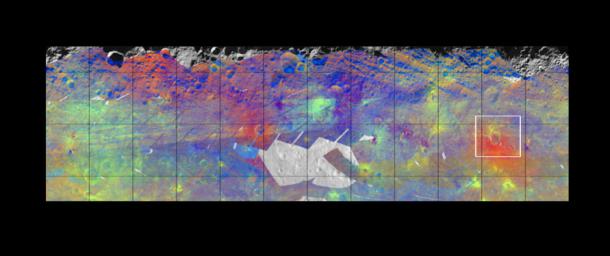This figure from NASA's Dawn mission shows the varied minerals on the surface of the giant asteroid Vesta in false color. The colors, derived from data obtained by Dawn's visible and infrared mapping spectrometer, have been chosen to emphasize mineral differences on a half-mile (kilometer) scale. Data from the spectrometer also demonstrate that Vesta's surface and subsurface show localized areas of bright and dark hues.
Geological structures at scales of tens of miles (kilometers) often show mineralogical differences. The differences can be seen particularly around craters that are surrounded by ejected material and that have experienced landslides.Oppia Crater is highlighted in the white box.
Colors were assigned to ratios of particular infrared wavelengths to emphasize differences not visible to the human eye. In this color scheme, green shows the relative strength of a particular mineralogical characteristic -- the absorption of pyroxene, an iron- and magnesium-rich mineral. Brighter green signifies a higher relative strength of this band, which indicates chemistry involving pyroxene. On the other hand, reddish colors indicate a different mineral composition.
The data used to create this mosaic were collected in August 2011, at an average altitude of 1,700 miles (2,700 kilometers). The visible and infrared mapping spectrometer data lie over a mosaic made by Dawn's framing camera.
The Dawn mission to Vesta and Ceres is managed by NASA's Jet Propulsion Laboratory, a division of the California Institute of Technology in Pasadena, for NASA's Science Mission Directorate, Washington. UCLA is responsible for overall Dawn mission science. The visible and infrared mapping spectrometer was provided by the Italian Space Agency and is managed by Italy's National Institute for Astrophysics, Rome, in collaboration with Selex Galileo, where it was built.
More information about Dawn is online at http://www.nasa.gov/dawn and http://dawn.jpl.nasa.gov.

 Planetary Data System
Planetary Data System












